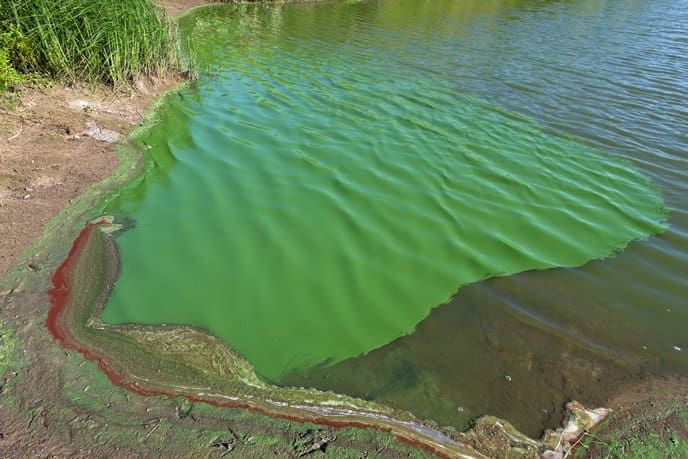It’s that time of year again: when rising temperatures lure dogs and dog owners to bodies of water, intent on cooling off, and when the water itself becomes dangerous to drink or swim in. The dangerous element, a toxic substance often called “blue-green algae,” is more accurately called cyanobacteria.
Genuine algae are simple plants; cyanobacteria refer to a group of microorganisms that possess characteristics of harmless algae, but differ from algae in that they produce highly potent toxins.
When the conditions are right, with high temperatures and shallow water, the population of this microscopic bacteria explodes, causing a sudden and highly visible “bloom” of blue-green scum on the surface of the water. That “bloom” is also responsible for the release of the toxins into the surrounding water.
One species is responsible for a type of skin irritation called “swimmer’s itch,” but the more notable danger is that oral consumption of the cyanobacteria can be quite toxic. Exposure to cyanobacteria has caused the death of many dogs, cattle, and even humans.
According to the World Health Organization: “Disease due to cyanobacterial toxins varies according to the type of toxin and the type of water or water-related exposure (drinking, skin contact, etc.). Humans are affected with a range of symptoms including skin irritation, stomach cramps, vomiting, nausea, diarrhea, fever, sore throat, headache, muscle and joint pain, blisters of the mouth, and liver damage. Swimmers in water containing cyanobacterial toxins may suffer allergic reactions, such as asthma, eye irritation, rashes, and blisters around the mouth and nose. Animals, birds, and fish can also be poisoned by high levels of toxin-producing cyanobacteria.”
The take-home point? At this time of year, keep your dog away from ponds, small lakes, and other shallow and warm bodies of water, even if he has swum in and consumed water from that water without any ill effects in the past. This is especially important if the water is green or covered with a green or blue-green scum. On hot days, your dog may race for a body of water to cool off in, so leash him up if you know you are getting close to a pond or lake that may have experienced an algal bloom with recent warm weather. And if your dog does manage to get into and drink from such a body of water, get him to your veterinarian as quickly as possible. Aggressive, immediate treatment may be needed to counter the serious, often deadly, effects of this fast-acting toxin.
For more information, see:
http://www2.epa.gov/nutrient-policy-data/cyanobacteriacyanotoxins







